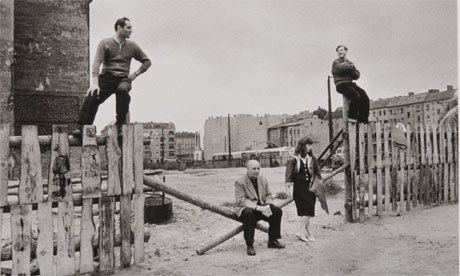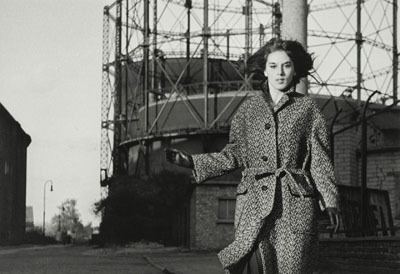Occupation Photographer | Name Arno Fischer | |
 | ||
Died September 13, 2011, Neustrelitz, Germany | ||
Showcase arno fischer and interview with andreas rost
Arno Fischer (born in Wedding, Berlin, 14 April 1927: died in Neustrelitz, 13 September 2011) was a German photographer and university teacher.
Contents
- Showcase arno fischer and interview with andreas rost
- Early years and war
- A lengthy training in sculpture
- Photography
- Middle years
- Changes
- Personal
- Public awards
- References

Early years and war

Arno Fischer's father worked as a type setter. Arno attended school locally from 1933 till 1941 when he started training in aspects of carpentry (wood carving/modelling, pattern making). On reaching 17 he joined the army in 1944/45 concluding his military career as a prisoner of war held by the British, who released him in 1946.
A lengthy training in sculpture

He was able to resume his civilian life in 1947, studying at the Käthe Kollwitz art school in Berlin where initially he attended drawing classes before switching to (wood) sculpture. He moved on in 1948 to Berlin's Weißensee Arts Academy where he continued with his study of sculpture and where he remained till 1951. By this time the political division of Berlin between the eastern part, which was administered by the Soviets and the western parts of the city, divided into three sectors controlled respectively by the French, the British and the Americans, was looking more permanent than had been widely anticipated a few years earlier, and the move to Weißensee involved a move from West Berlin to East Berlin. He moved on again in 1951, and from then till 1953 he was a student at the (recently renamed) Visual Arts Academy back in West Berlin, studying sculpture under Alexander Gonda.
Photography

Later Fischer recalled that he took his first photograph in 1944, of Berlin burning as Germany's defeat in the war loomed. He never received any formal training in photography; but nor, after 1944, did he ever lose his interest in it, and as his studies progressed he became aware that he was unlikely ever to make much money out of sculpture. His move into the world of photography started in 1955/56 with a year as a laboratory assistant at an X-ray institute. In 1956 he returned to the Arts Academy in Weißensee with a mandate to set up an archive, work as a general assistant, and "take photographs". By 1957, still without any formal photographic training, he had a job with The Academy as Senior Assistant to Prof. Klaus Wittkugel, a position he retained till 1971.
In addition he undertook photo-journalistic assignments for the fashion and arts women's magazine "Sibylle" and for other periodicals. His growing body of fashion and travel photography from the second part of the 1950s were set firmly in the new "Life photography" mainstream. Fischer later said that the focus of his photography work was on the condition of society, the interpersonal relationships of people, the core condition of the individual and his/her existence. These features are abundantly evident in "Situation Berlin", another project on which he worked between 1953 and 1960. By 1960 he was working very intensively on preparing for publication by "Edition Leipzig" of the resulting collection, evoking the moods and sights of the rapidly changing city in the 1950s. Pictures from the book, by now fully written and prepared for launch, were on display on the publisher's stand at the Leipzig Book Fair in the Autumn of 1961. The fair was held very shortly after the government had suddenly started their feverish construction of the Berlin Wall which for the next (nearly) three decades would cut off East Berlin from the west. A group of officials stopped off at the publisher's stand to look at some of the pictures on display under the "Situation Berlin" banner. One said to the others the chilling words, "Berlin ist kein Situation mehr" ("Berlin is no longer a situation"). The reference was to the way that the exodus of East Germans to the west through Berlin had been blocked by the new wall, but the meaning for Arno Fischer and his publishers was that "Situation Berlin" was not going to be published within foreseeable time.
Middle years
Arno Fischer was once asked whether in the wake of his experience with "Situation Berlin" he was ever tempted to try and escape from East Germany, but while he sometimes found the country's bureaucratic constraints limiting, he was generally accepting of the situation in which he found himself. A change of managing editor at "Sibylle" gave him freedom to develop, apply and promote his own ideas on fashion photography while status as a distinguished photo-journalist gave him excellent travel entitlements: some of his most celebrated fashion/celebrity shots, notably a set taken of Marlene Dietrich in 1964, were taken while traveling on assignment in Moscow. In 1965/66 he and a like minded group of East German photographers founded a Photographers' Group which in 1969 became known as "Direkt". Mutual acceptance of and by the establishment was also evident in the guest lectureship which he held in 1972/74 at the Higher Academy for Visual Arts (HGB / Hochschule für Grafik und Buchkunst) at Leipzig. From 1975 till 1982, together with Peter Voigt he was responsible for selecting the photographs shown on the Image Display Pillars flanking the Marx-Engels Forum which contained Ludwig Engelhardt's politically important Marx Engels Memorial. In 1981 Fischer was involved in the co-founding of the Photographers' Working Group in the national Visual Artists' Association (VBK) and 1983 he took a teaching contract back at the HGB where between 1985 and 1993 he held a position as Professor for Photographic Arts.
Changes
Changes experienced during the built up to reunification and its aftermath brought upheaval to the world of women's fashion magazines: Sibylle, after staggering on for a few more years, finally ran out of money in 1995. More positively, Fischer's international reputation was no longer constricted by the political isolationism of the old German Democratic Republic. With his wife,he involved himself in "Almediterrana 92" a major photographic project in Spain, and his work was increasingly exhibited across and beyond Germany. "Situation Berlin" was finally published in 2001. On the teaching front, Fischer took a lectureship in photographic journalism at the University of Applied Sciences and Arts in Dortmund, which he retained till 2000, and there was also a new teaching contract at Leipzig in 1993.
Personal
In 1985 Fischer married Sibylle Bergemann, a former student who by this time was developing a formidable reputation of her own as a photographer.
At the end Arno Fischer would predecease his wife by just fifty days.
